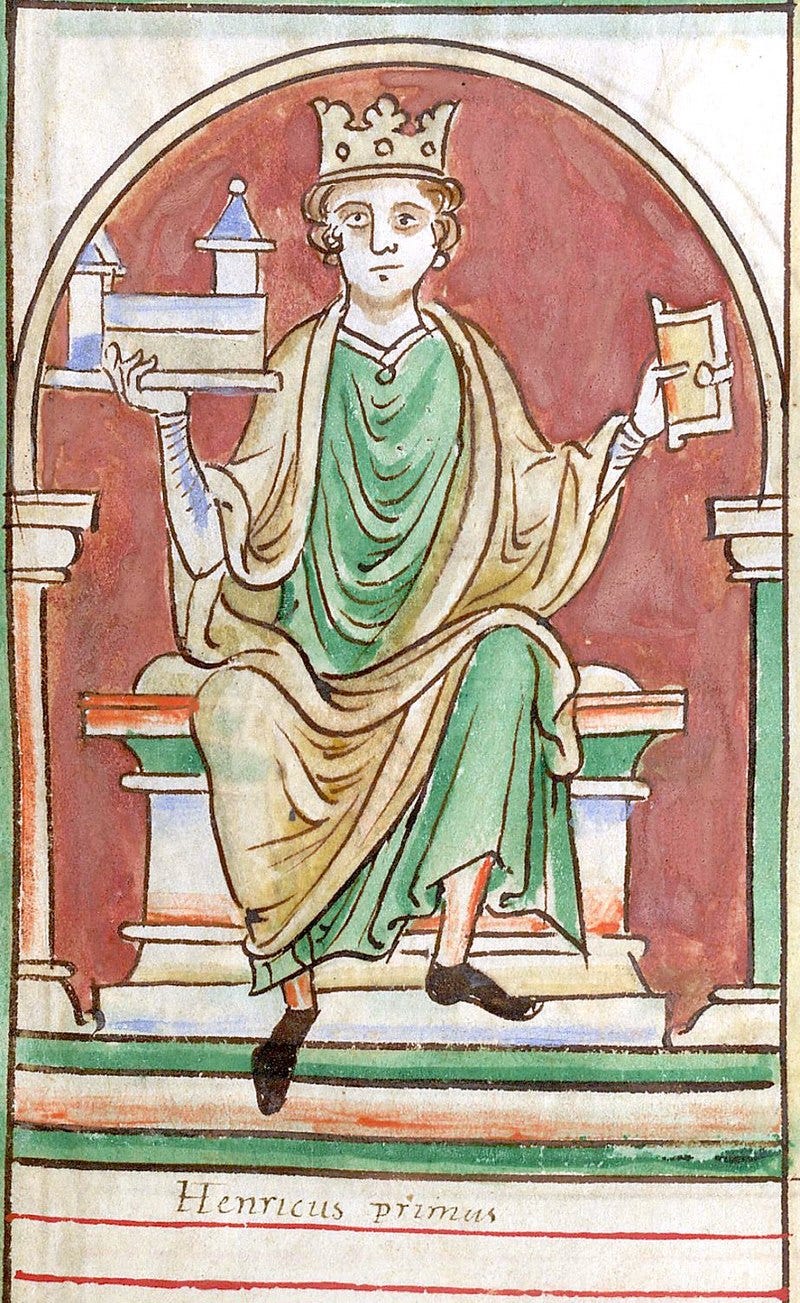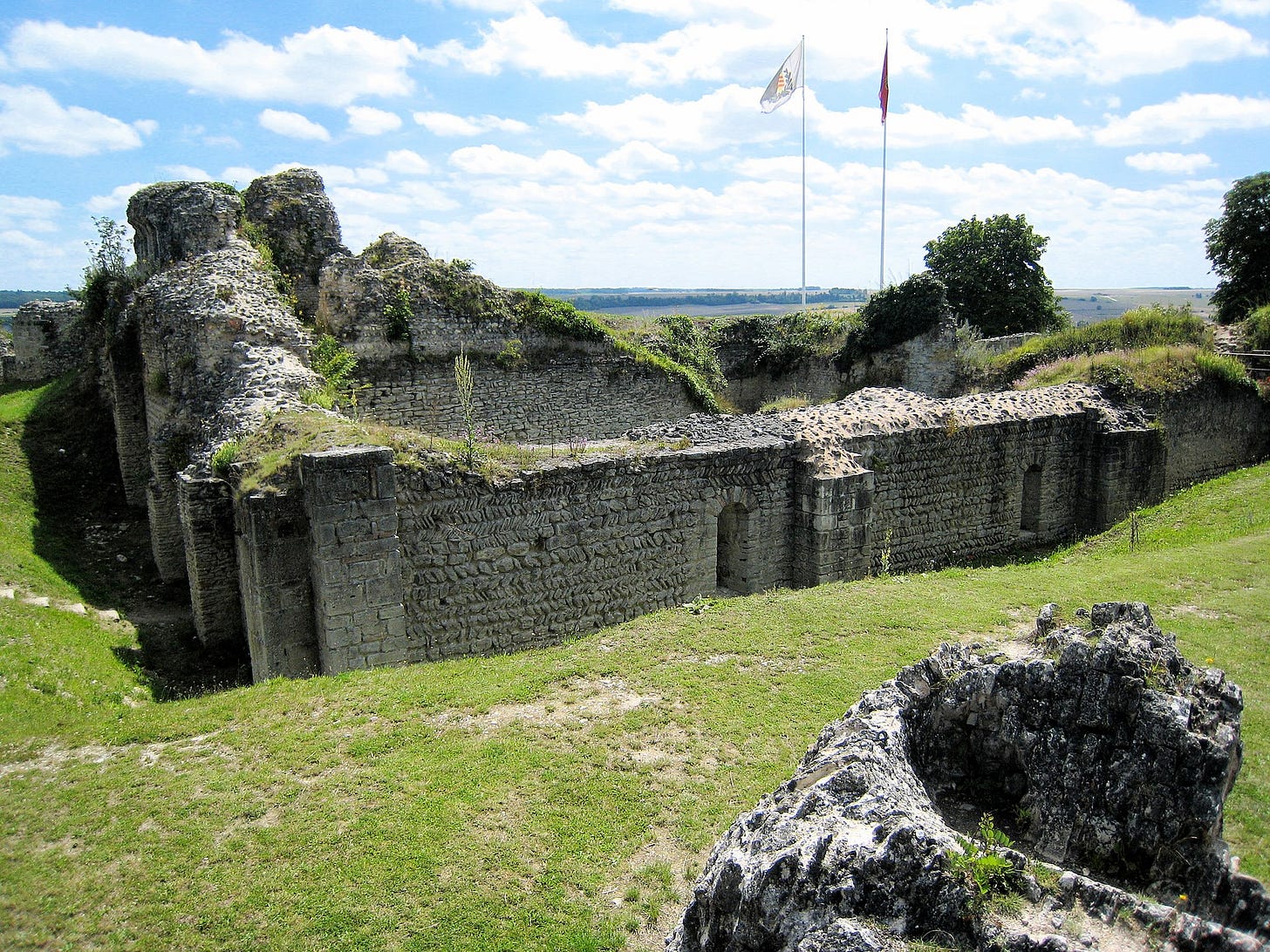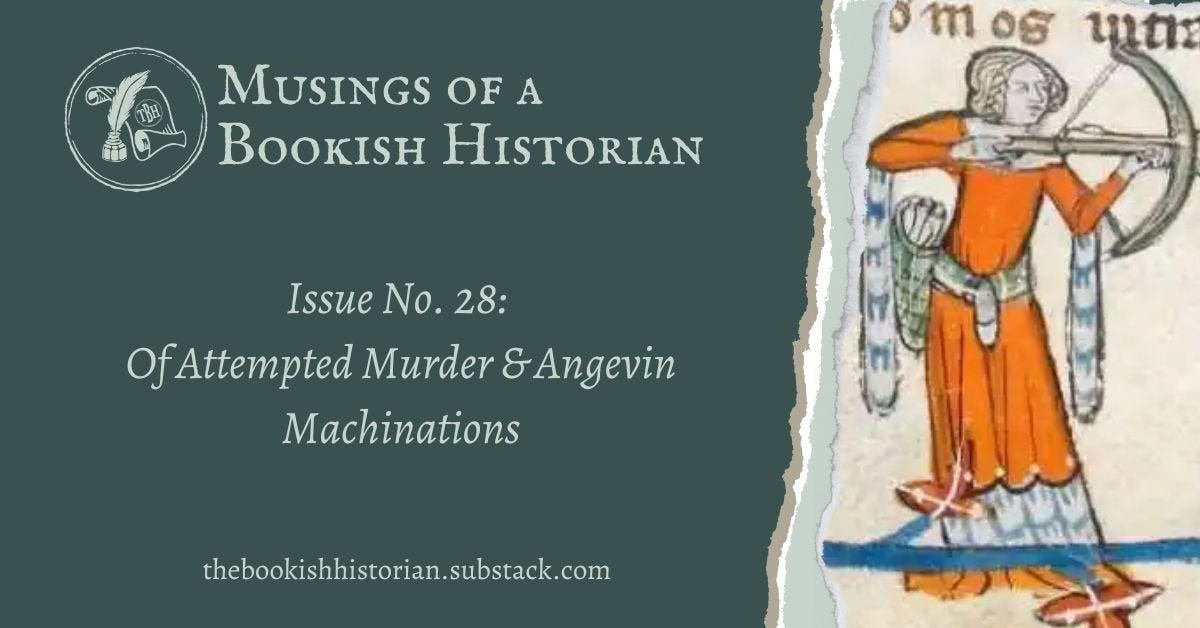Issue No. 28: Of Attempted Murder & Angevin Machinations
Juliana de Fontevrault, reciprocal bloody acts, and Lannisterian-style attempted patricide
Juliana’s attempted patricide of Henry I by crossbow is a distinctly Lannisterian method of death - albeit minus the whole “dying in a garderobe” bit.
“All is fair is love and war.” This idiom, attributed to John Lyly’s Euphues: The Anatomy of Wit, states that normal behavior and courses of action do not necessarily apply in military or romantic situations. Take, for example, the tale of Henry I and his illegitimate daughter Juliana de Fontevrault. The relationship between father and daughter bears the hallmarks of a traditional Greek tragedy, full of hubris, betrayal, and, sadly, blood feuds.1
As is often the case for medieval women, we know little of Juliana’s life. The only source for her life - and the sole basis for the story I’m about to share - comes from Orderic Vitalis in his Ecclesiastical history of England and Normandy. Orderic Vitalis (1075 - c. 1142) was an English chronicler and Benedictine monk in the service of Roger de Montgomery, Earl of Shrewsbury. His chronicles form one of the most important sources of medieval Anglo-Norman history.
Settle in, and learn about a little-known event that could have easily inspired George R.R. Martin.
(Note: Due to the length of this article, I’ve decided to not add suggested reading or a related artifact/history place this week, as both are somewhat included within the article. I’ve added a list of sources/further reading, and you’ll learn more about Ivri Castle below!)
Juliana de Fontevrault, Attempted Murderess?
Summary of the Political Landscape in 12th-Century England & Normandy
During the early 12th century, Henry I, King of England, also held the title of Duke of Normandy. After William the Conqueror - Henry’s father - passed away in 1087, he split his lands and titles between his sons, each receiving their own patrimony:
The eldest, Robert Curthose, inherited the duchy of Normandy
The second-eldest, William Rufus (r. 1087-1100), inherited the English crown
The youngest, Henry Beauclerc (r. 1100-1135), received money to buy lands
The distribution of titles and lands failed to satisfy Robert Curthose, who felt England was his due.2 In 1088, he launched a failed invasion in England (because he, quite literally, never showed up). William Rufus retaliated by invading Normandy, defeating Curthose’s troops, and requiring that his brother cede some Norman lands. Things remained separate until, like a bad penny, Curthose returned to nuisance William's successor Henry.
Ultimately, however, the duchy of Normandy and the kingdom of England merged after Henry I defeated Curthose at the Battle of Tinchebray in 1106. And poor Duke Robert was imprisoned for the rest of his life at Cardiff Castle (but, on the up side, he lived into his eighties, an accomplishment few people in Angevin England could claim for themselves!).

As the brothers fought over Normandy at large, smaller scale conflicts also erupted all over the duchy. Such was the case with Breteuil, a city in central Normandy.
The first lord of Breteuil was William FitzOsbern, a companion and cousin of William the Conqueror, and his descendants - his first-born son William of Breteuil and grandson Eustace - ruled over the landholdings during the time of Curthose and, later, Henry I. As they served as the nominal Dukes of Normandy, the Breteuils owed each brother their loyalty.
After William of Breteuil’s death in February 1103, the Normans chose his illegitimate son Eustace as his replacement. This precipitated a succession dispute, brought on by William’s legitimate (but not Norman) nephews. In their eyes, why should a bastard inherit what should rightfully be theirs? Orderic writes that “the parties flew to arms with great violence, and the country was further desolated.”3 Ah, the battle for the Breteuil Throne had begun.
So, how do Henry and his daughter fit into all of this politicking? And why does it even matter?
Juliana, Eustace de Breteuil, & the Castle of Ivri
As I mentioned above, we know little about Juliana. And what we do know comes from her association with her father and brother. Juliana was born before Henry became king, probably around 1090. Her mother's identity is unknown, though Orderic states she was a “concubine”, possibly named Ansfrida.
Despite being illegitimate, Juliana's royal birth merited her position as a marriage candidate. So, as his cousins drummed support among other nobles, Eustace de Breteuil entreated Henry for assistance in 1103. In turn, Henry offered his military support and his daughter Juliana as a token of good faith.4 They married shortly afterwards and had at least two daughters together.
Through Henry’s intervention, Eustace succeeded in reclaiming his birthright and making peace with his neighbors, for the time being, anyways.5 Eustace and Juliana settled in as lord and lady of Breteuil for a number of years.
In 1118, however, the tides of Norman politics shifted again. “Eustace de Breteuil,” Orderic chronicles, “was frequently advised by his countrymen and kinsmen to break with the king, unless he restored to him the castle of Ivri, which had belonged to his predecessors.”6 Presently, Ivri - a strategic stronghold on the border of Normandy and France - belonged to a different Norman magnate, Robert Goël. Being the savvy bloke he was, Henry “put Eustace off with his accustomed vague assurances”, to quote C. Warren Hollister.7

In an effort to stave off further conflict and ensure Breteuil’s loyalty, Henry arranged a hostage exchange, comprising his two granddaughters - the daughters of Juliana and Eustace - and the son of Ralph Harnec, Ivri’s constable.8
What could possibly go wrong?
Attempted Rebellion & Attempted Patricide
One might think that Juliana and Eustace would take the exchange of hostages seriously, despite the uncertainty of Ivri’s future possession. And yet, this couldn’t be farther from the truth. The couple inched towards rebellion, and things escalated in a way that maybe no one could have foreseen. Indeed, Hollister remarks that Orderic’s account of the following events “defies belief”.9
Instead of negotiating with Henry in good faith - if even such a thing were possible - Eustace and Juliana did something else entirely, something horrific. In Orderic’s own words:
Eustace shamefully treated the hostages he received, for at the instigation of Amauri de Montfort, who used every artifice that malice could suggest to renew the quarrel, and made many promises to Eustace on oath which he never performed, he put out the boy’s eyes, and in this state sent him back to his father, a most worthy knight.10
In response to this treasonous and horrendous act:
Henry, receiving intelligence with lively grief, delivered up his two granddaughters, that the father might immediately wreak his vengeance on them. Accordingly, Ralph Harenc, with the permission of the incensed monarch, seized Eustace’s daughters, and savagely tore out their eyes and cut off the tips of their noses…11
I have to wonder, at this point, if Juliana and Eustace considered the impact of their actions, especially when they found out about Harenc’s revenge. Orderic reports of their grief, but did it come as any surprise that Henry allowed the mutilation of his own grandchildren?12 Placed in context against the rest of the king’s reign, perhaps not as he held power close to his chest and rarely allowed any challenge to his authority to go unpunished. Additionally, retaliatory mutilation was the order of the day in medieval hostage relations.
In the aftermath of these bloody acts, Eustace sent Juliana back to Breteuil to fortify its defenses while he did the same at their other properties. However, the town’s burgesses weren’t all that cooperative in light of their lord’s and lady’s acts. Instead, they sent word to Henry, who besieged the city. Juliana was caught between a rock and a hard place, and how else to remedy the situation by attempted patricide?
Henry’s illegitimate and wayward daughter arranged a meeting with her father - perhaps under the pretense of negotiating terms - and, instead, met him with a crossbow. She “launched a bolt at him, but through God’s protection, he escaped unharmed.”13 Juliana’s attempted patricide of Henry I by crossbow is a distinctly Lannisterian method of death - albeit minus the whole “dying in a garderobe” bit.
The Aftermath
Now, one can imagine that trying to kill one’s father boded ill in the Middle Ages. But, was Juliana all that bad as Orderic made her out? Not necessarily. For one, Orderic was a Benedictine monk, and the Catholic faith treated women very poorly in many sources, viewing them mostly as methods of procreation and otherwise fallible beings.
Indeed, Orderic prefers to focus on Juliana’s humiliation in the aftermath of her failed murder attempt even after the loss of Breteuil and other holdings.14
Her defeat and loss of the castle were not enough in Orderic’s narrative. The historicity of the tale is less important than the fact that Orderic uses voyeuristic detail to portray her in a demeaning and humiliating way. Juliana was in a difficult political situation where conflicting family ties made her position as wife and daughter of protagonists difficult: her loyalty to her husband is, however, predominant. The allegation of her intention to commit patricide is indicative of Orderic’s awareness of her pain, rage and anger at the mutilation of her children.
Did Juliana actually try to murder her father? Given that Orderic provides the only account of this, we may never know. But it’s clear that Orderic viewed the epilogue to Eustace and Juliana’s tale very differently, with the noblewoman receiving a more scathing assessment. After the failed rebellion, Eustace lost his fief of Breteuil and most of his possessions. In recompense, Henry offered Eustace a large annual sum, and Eustace retained the city of Pacy. He “lived in great wealth for more than twenty years”.15 Juliana, on the other hand, “abandoned her loose mode of life” and retired to the Abbey of Fontevrault.16
Henry I’s notorious illegitimate daughter died sometime after 1136. It’s a shame that we don’t have any sources to compare against Orderic’s account. Given the monk’s background and the prevalent view of medieval women, I would wager there’s more to the story than we know. But then again, maybe Juliana really was a Lannister at heart.
Sources & Further Reading:
Hollister, C. Warren. Henry I. New Haven, CT: Yale University Press, 2001.
Johns, Susan. Noblewomen, Aristocracy and Power in the Twelfth-Century Anglo-Norman Realm. Manchester, UK: Manchester University Press, 2003.
Thompson, Kathleen. “Affairs of State: the illegitimate children of Henry I.” Journal of Medieval History 29 (2003): 129-151.
Vitalis, Orderic. The ecclesiastical history of England and Normandy, ed. Thomas Forester. London: H.G. Bohn, 1853-1856.
Featured image: Woman with a crossbow (©The British Library, Smithfield Decretals 1300, 1340 f.43)
That is, if one chooses to indulge in some minor histrionics.
It’s important to note, however, that the French method of inheritance to which the Conqueror subscribed was not anything out of the ordinary.
Orderic Vitalis, The ecclesiastical history of England and Normandy, Vol. III, ed. Thomas Forester (London: H.G. Bohn, 1853-1856), 344.
Ibid. Vol. III, 345; C. Warren Hollister, Henry I (New Haven, CT: Yale University Press, 2003), 179. It’s interesting, though, that Robert Curthose - as Duke of Normandy - fails to appear in the Breteuil inheritance conflict, a point observed by Hollister. The author attributes Curthose’s “invisibility” to his generally indifferent rule over Normandy as well as the birth of his son William Clito in October 1102.
Ibid. Vol. III, 347.
Ibid. Vol. III, 465.
Hollister, Henry I, 253.
Ibid., 253.
Ibid., 253.
Vitalis, Vol. III, 473.
Ibid., 473-474.
Hollister asks this same question: “Why Eustace would have mutilated an innocent young man-and thereby put his own daughters in the gravest jeopardy-is impossible to fathom” (p. 254).
Ibid., 475.
Susan Johns, Noblewomen, Aristocracy and Power in the Twelfth-Century Anglo-Norman Realm (Manchester, UK: Manchester University Press, 2003), 18.
Vitalis, Vol. IV, 117.
Ibid., 117.







